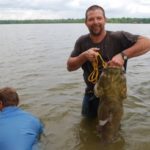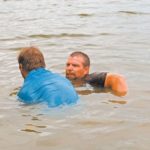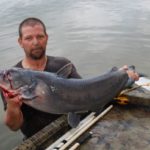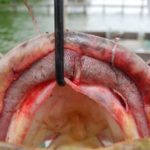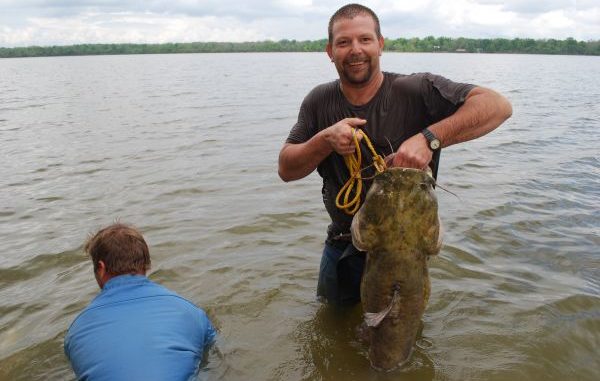
These catfish grabbers could be viewed as braggarts, but they can back up their big words with big fish. Learn how they consistently drag big flatheads into their boat.
The strikingly handsome young man piloting the big pickup truck wore confidence all over his body like a hard shellac veneer. At only 30 years old, he was the youngest but clearly alpha male of the three-person catfish-grabbing crew.
“It’ll be like picking blueberries. We’ll get them,” he predicted.
Bold talk — the kind that makes me nervous. My apprehension must have showed because he glanced at me and became even more assertive.
“Don’t worry; we’re going to kill them,” he promised. “We’re going to have a good day.”
“How long have you been diving Lake Larto,” I asked, looking for reassurance.
“Last year was my first time,” but he quickly added, “Don’t let that fool you — I catch fish! Like my uncle Alfred (his catfish-grabbing mentor) told me, ‘There’s a lot I can’t do, but catching fish ain’t one of them.’”
More bold talk?
I was already twisted inside. Last night at his camp, I got the distinct feeling that he was sorry I was there, an outsider there to give away his hard-won secrets, even though I was there at his invitation.
Now, on top of that, I was worried about them catching fish on this, their first grabbing trip of the year. Last night he fessed up that he wasn’t taking me to his best spots — his secret spots.
Because Larto Lake is relatively new to Andrews, we would be concentrating our efforts on concrete boat ramps. For a bunch of reasons, including fish activity, large cavities develop under the ramps and form ideal dens for spawning flatheads.
I knew Andrews was hard core and had been grabbing catfish since he was a kid. During the hour-and-a-half ride to the lake, I got to know his partners, Chuck and Kelli Thornton, a little better.
Chuck, at 42, is almost half again older than Andrews. Just as tall but more powerfully built than Andrews, he wears a dashing goatee on his open, friendly face. Kelli, his wife, is a vivacious, brown-eyed brunet who speaks with a sweet Mississippi drawl.
Both love to grab catfish.
“I remember when I grabbed my first fish,” Chuck recalled. “Oh, the adrenaline rush; it felt indescribable. I’ve been here ever since.”
Kelli echoed her husband.
“I’m kind of like Chuck. I like the rush, the anticipation when I put my hand in a hole — will I get bit or not?” she said. “Your hand is like bait. I love it. I have no fear of it.”
“Kelli is something. She’s real good. She helps a lot,” Andrews interjected. “Blue catfish bite worse than flathead cats. When we find a blue cat, we leave it. You can feel the difference.”
I guess I gave him a cockeyed look.
“Why would I take a blue cat when I have No. 1 fish, flatheads?” Andrews explained. “I give a lot of fish away — church functions, youth groups, things like that.”
A distinct note or irritation crept into his voice as he continued.
“Some people ask why I don’t turn them loose,” he said. “When I put in my time and money, don’t tell me what I need to do with the fish I catch. When I catch them, they are mine. I do what I want with my fish.”
Chuck backed him up.
“Some people say we are hurting the population by taking spawning fish,” Chuck said. “People have been doing this for years and years, and we are still catching 50- and 60-pound fish.”
“That’s just ignorance,” Andrews snorted. “They raise heck when they see pictures of my big fish on the Internet.”
We passed the old Larto schoolhouse, a signpost that we were nearing the lake. When the big oxbow — an old channel of the Mississippi River — came in view, Andrews cooed.
“Lookie here, lookie here,” he said. “Them fish don’t know what’s fixing to happen. It’s going to be like taking baby from a candy.”
“Baby from a candy,” questioned an amused Chuck, while Kelli laughed out loud.
“Same difference,” grunted Andrews.
“More bold talk,” I thought to myself.
The trio quickly loaded the boat and backed it down the steep ramp into the lake. Before Chuck got the truck parked, Andrews was thigh deep in the water, checking out the edges of the boat ramp for undercutting that could indicate a den.
“Nothing here,” reported Andrews to the returning Chuck.
In a pattern that would be repeated all day, they ran the boat from ramp to ramp. With the boat’s bow pulled to shore, Kelli would get out and hold the boat, and both men would dismount and check the edges of the ramp all the way to its end, typically in 4 to 5 feet of water.
There were a lot of private boat ramps, far more than one would remember from just a casual boat ride along the shore. Every second or third camp seemed to have one, and the shoreline was solidly built up with camps and homes.
“They are looking for holes that aren’t ‘blow-outs,’ holes with huge entrances that are impossible to block,” Kelli explained.
“Sometimes the whole submerged end of a ramp is eroded from under the concrete, creating a 5- or 6-foot overhang,” Andrews added.
The first three ramps yielded nothing — no holes; no fish. But at the fourth ramp, Andrews went underwater to use his hands.
His head popped back out of the water and he wiped his eyes.
“There’s a hole, and there’s one in there,” Andrews said. “It’s clean, clean, clean! Give me my pole and the air, too.”
His head soon popped up again.
“He’s way back in there,” he said, pointing at a spot 10 feet from the edge of the ramp. “Give me the long pole.”
The poles Andrews referred to are small-diameter PVC pipes in 5- and 10-foot lengths. Some are bare poles. Others have a large, shark hook taped to one end with that most indispensable of their tools, black electrical tape.
The hook’s eye is set in a loop braided into a poly rope, and the rope is slightly longer than the poles. The opposite end of the rope also has a loop braided into it, so if a big catfish twists the hook from the pole, the grabber can retrieve the fish with the rope.
Andrews was under a long time this time. Bubbles from his air supply roiled the surface, and occasionally a foot stuck up. Even though the water was only crotch deep, Chuck had to stand on his back because he forgot his weight belt in the boat.
Finally, up he came again.
“It’s about 30 or 35 pounds,” Andrews said as he spat water. “The fish is biting the end of the pole.”
He hadn’t felt the fish with his hands, yet, but he was experienced enough to guess its weight. Since his efforts to prod the stubborn fish to the den’s entrance weren’t working, he asked for a long pole with a hook on it.
The aggressive fish chomped down on the pole again, but this time it had a hook on it. Andrews yanked the hook home and surfaced with the indignant cat — a 30- to 35-pounder, just like he had called.
Back in the boat, he explained that the entrance to the den was about the diameter of a 5-gallon bucket, but the den itself under the center of the ramp was about the size of a car hood.
“Sometimes the holes are so big it makes you wonder what holds the ramp up,” Chuck said.
I pondered how many unknowing fishermen had launched their boats right over the fish.
The next ramp — a big one and an old one — had Andrews fairly salivating. Both men grabbed their air lines and bailed out of the boat.
The lone fish at the ramp was on Andrew’s side again. It was in a big hole, but he was able to hem it in on one side of the den and run his hand through one gill cover and out of its mouth.
“There is no technique,” Andrews explained. “You just grab them any way you can.”
Andrews judged it “too small to keep” and turned it loose.
A couple of ramps later, the fish was on Chuck’s side. But it was a little 2-pound channel catfish, which he chunked back after showing it to me.
Andrews snorted that he even brought it to the surface.
Several ramps produced no holes, but there was no shortage of launches to check. There seemed to be one every couple hundred yards.
Then Andrews surfaced to declare that he had a big one in a hole. Chuck, who was standing on the ramp agreed.
“I can hear him thump under the ramp,” Chuck said.
He joined Andrews to make sure that the exit hole was completely blocked.
The fish charged out of the hole and hit Andrews hard, but he got his hand in its mouth and pulled it to the surface.
The 50-plus-pounder went berserk, throwing water high into the air, but Andrews wouldn’t let him go. He carefully strung the monster on a rope stringer before posing him for a picture.
At the next ramp, Chuck located a clean hole on his side.
“Listen to this,” Andrews said. “The fish is going wump, wump. It sounds like thunder.”
Chuck worked the hole hard, but when he got his hand on the fish, the smile turned to a look of disgust. It was a 10-pound channel catfish — huge for its species, but not what he was looking for.
Andrews laughed like crazy; all the flatheads so far have been on his side of the ramps.
Every hole is a puzzle and the two men have to strategize how to block every exit when they find someone home.
The next flathead came from a den that had an opening on both sides of the ramp.
Working from his side, Chuck hooked the fish in the tail with his pole, but the hole on his side was too small to pull the fish through. Andrews snaked his pole in to the fish and hooked, it as well — also in the tail.
Chuck had to release his pole for Andrews to pull the fish and his pole out of the other side of the ramp.
It was a good 40-pounder.
During all the activity of the morning, Andrews was unbelievably secretive. Pickup trucks slowed to a crawl on the road above and along the lake, their drivers and passengers craning their necks to see what was going on. Every so often, someone would walk to the crest of the bank above them to watch.
Whenever they had an audience, Andrews would beckon Chuck to submerge any fish they were handling. Instead of fishing, they would just fiddle around in the water until the prying eyes were absent.
“I don’t want people seeing what I am doing,” Andrews said with a suppressed grin.
The next hole was a big one, too large for one man to work.
The pair was probing side by side when a big shape rocketed out of the water and disappeared in a flash. It looked like a blue cat, but it happened so quickly neither could be sure.
Andrews kept feeling and probing with an intense look on his face.
“There he is,” he grunted. “I think I got him. Ugh, he came off.”
Finally Chuck hooked the fish and hauled it out. To Andrew’s intense amusement it was a 25-pound blue cat, which Chuck promptly turned back.
Chuck’s luck finally broke for the better, when by extending one leg deep under a ramp and located a flathead.
Without waiting for his air line, he held his breath and went down head first. When he came up, it was with a 40-or-so-pound flathead hooked on his pole
Chuck finally had a flathead, all on his own.
As luck would have it, the next fish was on Chuck’s side of the ramp again. He called Kelli, who had been the men’s “go-fer” until now.
“Here honey,” he said “He’s all yours.”
Kelli immediately got a hand in the fish’s mouth and brought it to the surface.
It was about a 20-pound blue cat that was madder than a wet hen. The fish chomped down hard on her hand and started twisting wildly.
“Oh, he’s biting me” she yelled. “He’s going to pull off my rings. Ouch, ouch, ooch, ooch, yeow,”
Her husband was trying to help her, but was handicapped because he was laughing so hard. He finally got a grip on the muscular fish and pried its mouth open to release Kelli’s hand.
While he released the fish, Kelli promptly climbed in the boat and nursed her injuries.
“At least, he didn’t get my rings,” she consoled herself.
The last flathead of the day came from a den with exit holes on opposite sides of the ramp. Chuck blocked one hole while Andrews dove on the other one. He seemed to be down an eternity, with nothing but bubbles from his air line coming up.
Finally, he burst from the water, hugging a flathead weighing a little over 20 pounds.
In spite of seeming to be down a long time, he said the fish came easily.
“It just swam right up to me,” Andrews explained.
The men decided to pack it in early with five flatheads, even though they were short of their average six to eight for a trip. A violent thunderstorm was closing in from the north, with slashing lightning and booming thunder.
Back at the landing, while they were icing their fish down, just what Andrews doesn’t want to happen, happened: A short, wizened old man with a white beard and long, grizzled ponytail strolled down the hill.
“Hey,” he greeted them, not unfriendly. “Let me ask ya? Y’all been a ka-noodlin’?”
Chuck and Kelli made themselves busy, acting as if they didn’t hear him. Andrews played dumb.
“What’s that?” he replied to the question with a question.
“That’s when people run their arms up holes and catch them big mudcats,” he answered while he eyed the monsters they were icing up.
Andrews went silent.
After a long pregnant moment, Chuck spoke without looking up.
“We caught them on worms,” he said.
The old man produced a gap-toothed grin.
“I know y’all ain’t caught them on no worms,” he said.
A long, long uncomfortable silence followed. I had to turn my back on them and walk away a bit to control myself.
Finally Andrews relented.
“We caught them grabbin,” he admitted.
“Well, that’s ka-noodlin’.”
The visitor flashed a victory grin before slowly sauntering up the ramp to the road.
During the long drive from the lake, one or the other of the trio would start giggling spontaneously.
“You been ka-noodlin’? I been ka-noodlin’. We been ka-noodlin’.”
They laughed all the way home.
